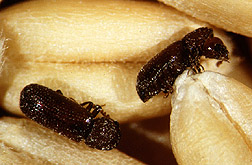|

Adult lesser grain borers.
Click the image for more information about it.
|
|

|
Getting a "Charge" From Bugs in Wheat
By Erin Peabody
May 21, 2007
How do you spot tiny insects that might be lurking inside grains bound
for the kitchen table? Give them a minor jolt, according to an Agricultural
Research Service (ARS) engineer.
Thomas
Pearson, who works at the agency's
Grain
Marketing and Production Research Center, Manhattan, Kan., has found a
novel and cost-effective way to detect the pesky insect larvae that
occasionally use kernels of our favorite cereal grains as their homes.
Several agricultural researchers, including Pearson, are hard at work
devising new and improved methods for helping inspectors screen our nation's
grain supply. Why? Despite rigorous scrutiny of grain at flour mills and
loading docks for overseas shipments, insects, in all their earthly abundance,
remain persistent invaders of stored grains.
Especially hard to find are immature insects—tender pupae and
larvae that metamorphose inside the nutrient-rich cocoon of a grain kernel
until they're ready to emerge as adults.
Pearson's detection system relies on three parts: a roller system for
crushing a sample of wheat, a voltage source for sending a charge through the
sample, and a computer software program for measuring aspects of the sample's
electrical conductance.
Kernels infested with larvae cause a noticeable spike in electrical
conductivity readings. Such increases are likely due to the hidden larvae's
moisture content.
For his study, Pearson intentionally infested batches of hard winter
wheat and soft winter wheat with two of the grain industry's most insidious
foes: the rice weevil and lesser grain borer. He allowed the contaminated
samples to "incubate" for several weeks so that stowaway insects had a chance
to multiply and grow, and so that their unnerving presence could be
independently confirmed.
Pearson's specially adapted roller mill can impressively screen about
30,000 kernels—or one kilogram of grain—a minute, spotting 80 to 90
percent of those infested with insect larvae. The cost of the device is
substantially less than other technologies for insect detection, including
x-ray and near-infrared systems.
ARS is the U.S. Department of
Agriculture's chief scientific research agency.